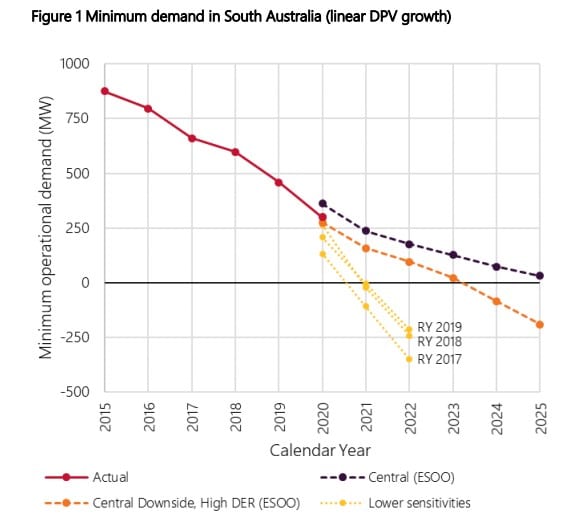The Australian Energy Market Operator has begun preparing for a future with zero or negative demand for electricity in parts of Australia’s main grid, seeking urgent changes to electricity market rules to avoid errors in the way certain payments are calculated.
AEMO has written to the Australian Energy Market Commission seeking the changes to the way certain payments are calculated, particularly when they are based on their share of energy flows.
As AEMO points out, during periods of negative demand, (caused when rooftop solar and storage matches or exceeds demand in the grid), the current equations used to calculate payments would produce some very odd numbers.
AEMO says the equations used to calculate a range of non-energy payments had been based on the assumption that there would always be positive demand within the National Electricity Market, and would break during a period of negative electricity flows.
It could cause problems for the calculation of payments for ancillary services, compensation paid to market participants because of actions taken by market operators and reserve contract payments.
To date, AEMO has calculated the amounts payable by market participants based on their share of ‘adjusted gross energy’ flows through relevant parts of the energy system. However, AEMO has proposed that this amount be substituted with an average amount during periods when energy flows are negative.
The need for the new rules is indicative of the fact that negative flows of energy, where production from behind-the-meter solar and storage devices exceeds the regional demand for electricity, which were never expected to be a major feature of the energy system.
“The [National Electricity Rules] framework assumes that any electricity flows in the opposite direction will be immaterial for cost recovery purposes,” AEMO says in its rule change request. “As the number of connection points with significant bi-directional electricity flows continues to grow, this assumption no longer holds and challenges emerge.”
“AEMO considers that zero or negative demand conditions are most likely to first occur in South Australia, due primarily to high bi-directional flows with continuing growth in distributed energy resources (DER) installed at load connection points. Some of AEMO’s most recent sensitivity studies indicate the possibility of regional demand reaching zero in South Australia in spring 2021.”
But with the growth of rooftop solar installations, particularly in a state like South Australia, which is now delivering a significant proportion of the state’s electricity needs, periods of negative market demand will become increasingly common.
Last year, demand for electricity from wholesale generators dropped below 300MW for several periods in South Australia, with rooftop solar providing more than 1,100MW of capacity, pushing demand for large-scale power to new lows.
In its request, AEMO cites projected minimum demand scenarios for South Australia which suggest the state could start seeing negative demand periods in 2021, with the frequency of negative demand periods increasing has the adoption of rooftop solar grows.
These trends have prompted market operators to prepare for a time when the supply of power from behind-the-meter systems exceeds total demand for energy in Australian states, which could start regularly occurring as soon as next year.
The Australian Energy Market Commission will issue a consultation paper to facilitate stakeholder feedback in the near future.










